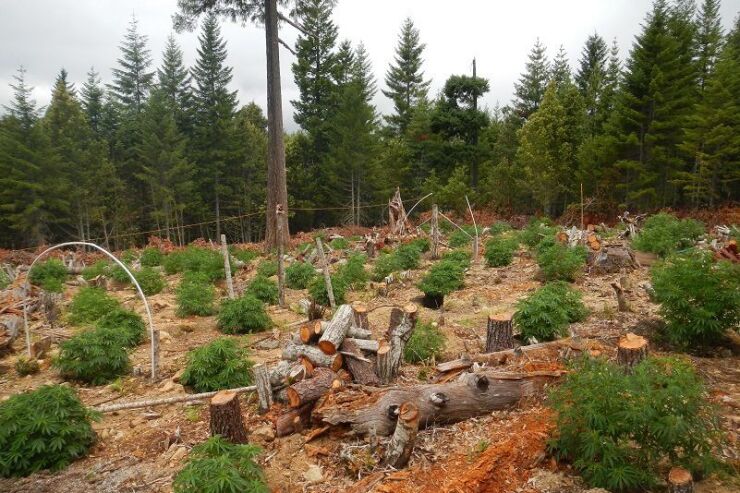California Department of Fish and Wildlife via Associated Press
In this undated photo provided by the California Department of Fish and Wildlife, fallen trees are shown amid a marijuana farm in the Klamath River watershed, just outside the Yurok Reservation near Klamath, California.
Clandestine cannabis grows are messing with water quality in four separate national forests, harming potential drinking water supplies downstream of the illegal operations.
The U.S. Forest Service has long suspected that these secretive “grows” are causing harm to wildlife, but the impacts are more insipid than that.
What the federal agency found: A six-year study by Forest Service law enforcement, investigative ecologists and other partners found the fallout of illegal cannabis operations is doing more than hurting terrestrial wildlife, including the federally protected northern spotted owl and Pacific fisher. After the extensive monitoring, researchers found illegal and banned pesticides have been unexpectedly detected in surface waters below these sites.
As reported by KRCR, there may be as many as 5,000 illegal grows in California forests alone and it is difficult for agencies to keep on top of eradicating the chemicals left behind in the soil and vegetation because it takes the forest five years to completely recover after a site has been eradicated.
Why it matters: National forest lands support over 50% of California’s freshwater, 75% of California’s fish and wildlife and 62% of native plants. The surface water in national forests provides critical aquatic and riparian habitat for many species, plus clean water to rural communities, agriculture, municipalities and Indigenous tribes.
“The results of this study were surprising and further highlight the need for the Forest Service to disrupt these clandestine sites and monitor their impacts to conserve the public’s natural resources for our and future generations to enjoy,” said Mourad Gabriel, co-author and the Regional Wildlife Ecologist for Law Enforcement and Investigations, Pacific Southwest Region. Mourad also serves as the Trespass Cultivation Ecology, Safety and Reclamation program lead.
Earlier this year, the U.S. Department of Justice announced a California man pleaded guilty to marijuana-related charges and ordered to pay nearly $50,000 in restitution for an illicit operation that while on his own property, occupied the Carter Creek watershed drainage network in the Sierra National Forest. He faces sentencing in January.
What the study ultimately found: Gabriel emphasized that Forest Service Law Enforcement and Investigations proactively removed over 100 pesticide containers from 56 illegal cannabis cultivation sites in 2022 before they could pose a risk to watersheds on national forest lands. “Our findings in this study show the need for proactive management of trespass cannabis cultivation sites to reduce or eliminate surface water contamination for humans, fish and wildlife,” Gabriel concluded.
More than just water at risk: Advocates estimate that California’s national forests, four of which ring the Los Angeles basin, are home to 80% to 85% of the country’s illegal marijuana grows on public land.
As reported by a California NBC station, in the past two years alone, grow operations in California have rerouted millions of gallons of water, caused a 125,000-acre wildfire in Big Sur and helped add at least one species to the endangered list. Because marijuana cultivators live at their grow sites for months at a time, they introduce hazards like cigarettes, open-flame stoves and wood fires to the tinder-dry forestland.
Toxic legacy: The Integral Research Ecology Center is a nonprofit center that studies the impact of grow sites on the environment and assists the Forest Service in its cleanup efforts.
It notes that some of the chemicals marijuana grow operators use are so toxic they have been outlawed in the United States for decades. The center added that some of the chemicals are so toxic and used in such high concentrations that a number of officers and cleanup workers have been hospitalized for exposure.
H/T: www.deseret.com



